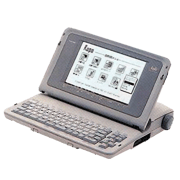Toshiba rolled out the Rupo JWR1, a personal word processor with a user interface specially designed for first-time users, in 1993. The JWR1 featured a task-driven menu interface, which provided printing menus for various tasks — such as postcards, name stickers, video labels, and banners — to streamline input, editing, and printing operations for each application. It also had a help menu that provided guidance on operations through dialogs and a visual guide, which used illustrations to explain operations. And Rupo Intro was included to practice basic document entering and editing.
| External dimensions [mm] and weight | 365 x 375 x 73 (w x d x h), 5.0 kg |
|---|---|
| Power supply | 100 VAC, 50 / 60 Hz, 0.6 A |
| Display device | Backlit white LCD screen 40 characters x 20 lines |
| Entry modes | Whole paragraph conversion (up to 60 characters) |
| Conversion | Conversion dictionary: 277,000 words (basic dictionary: 94,400 words; proper noun dictionary: 13,300 words; colloquial dictionary: 1,350 words)
AI conversion: 200,000 candidate words |
| User-defined dictionary | 450 words |
| Document length | 16,000 characters |
| Print function | Mincho outline (Gothic outline, Mouhitsu, and 12 alphanumeric fonts) |
| Western language functions | Alphanumeric entry, English spellchecker (65,000-word dictionary), user-defined spellchecker (up to 468 words), kana-English conversion (1,280 words) |
| Features for first-time users | Task-driven menus (postcards, labels, banners, business cards, name stickers, certificates, gift wrapping paper, tickets, iron-on transfers), help menu, visual guide, Rupo Intro |
| Optional functions | Data processing (graphs and spreadsheets), word-processing certificate training, postcard software, portrait montage, games |


